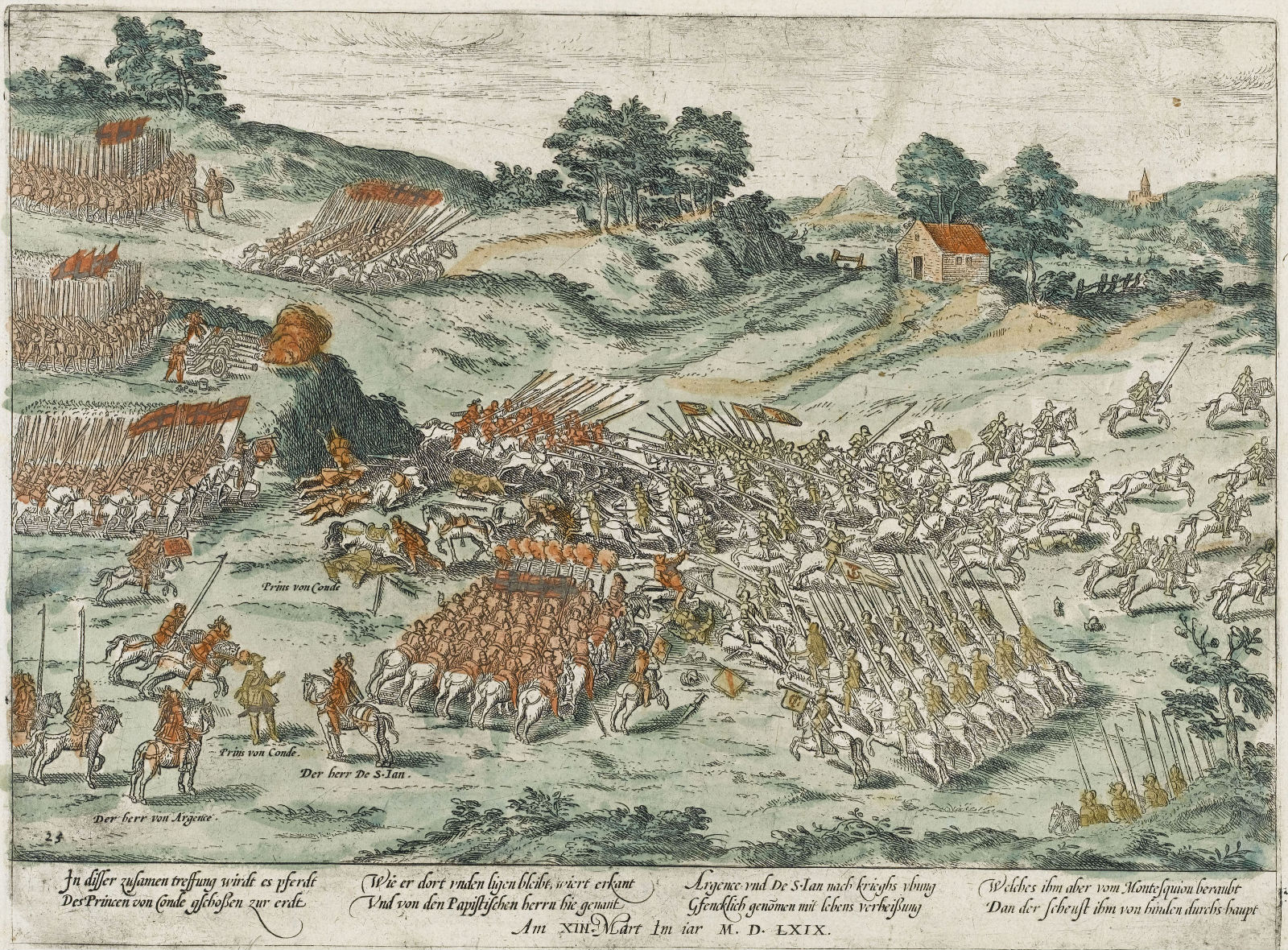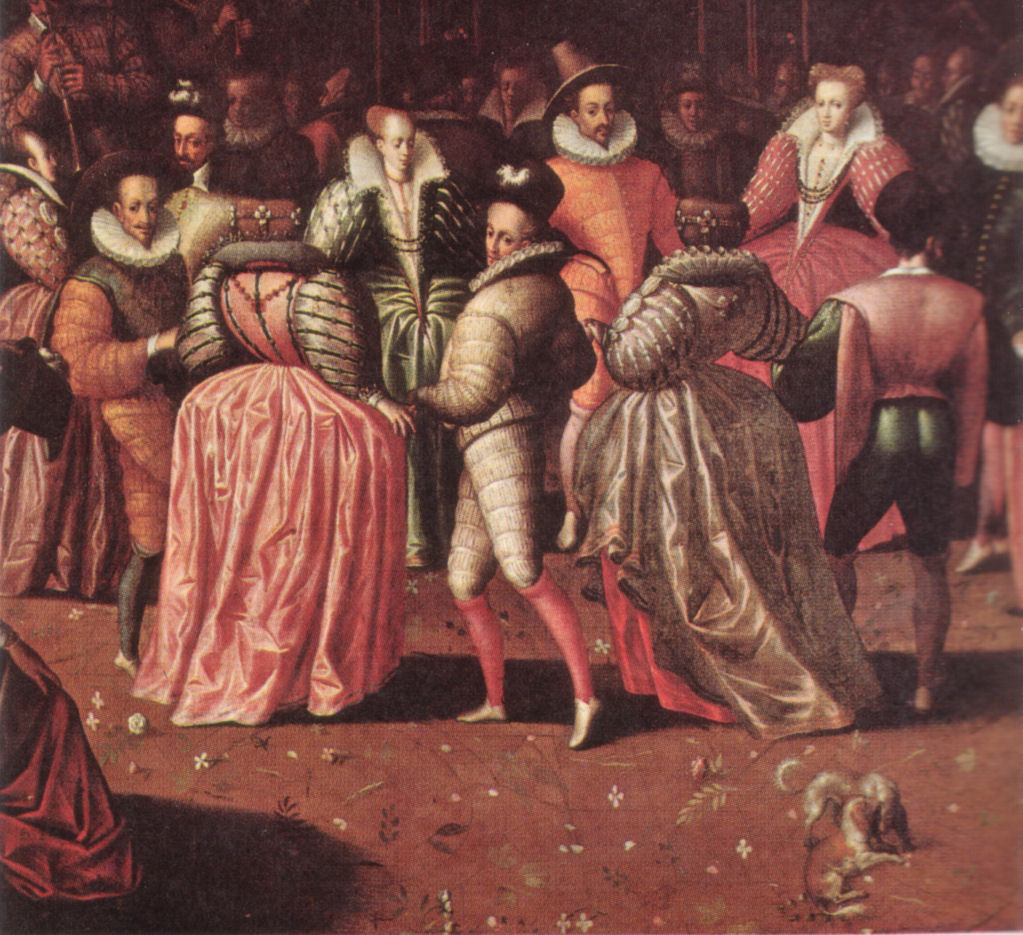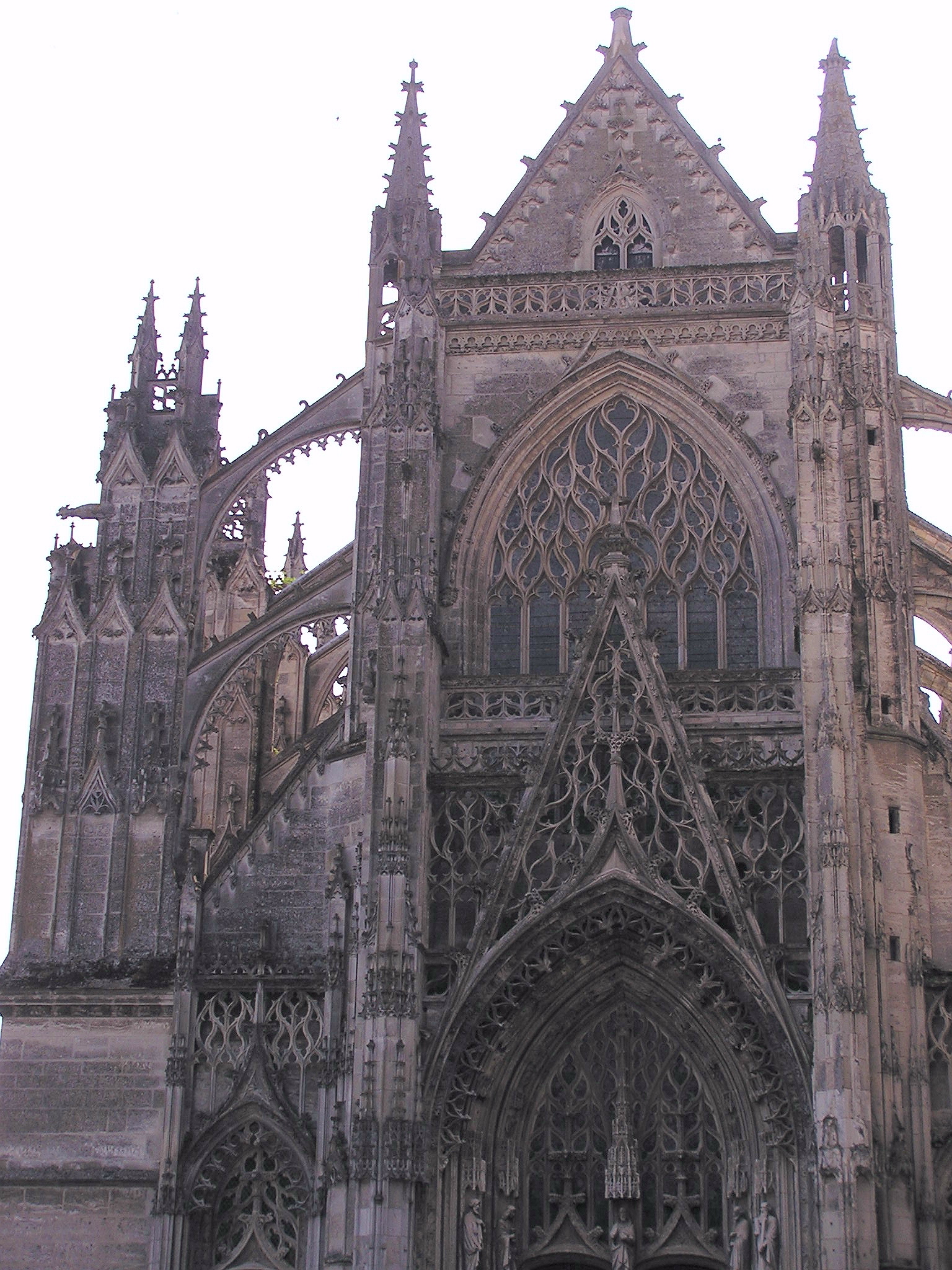|
Françoise D'Orléans-Longueville
Françoise d'Orléans (5 April 1549 – 11 June 1601) was the second wife of Louis de Bourbon, Prince of Condé, a " Prince du Sang" and leader of the Huguenots during the French Wars of Religion. Family Her paternal grandparents were Louis d'Orléans, Duke of Longueville, Sovereign Count of Neuchâtel, Prince of Chatel-Aillon, and Princess Johanna of Baden-Hachberg, Sovereign Countess of Neuchâtel and Margravine of Rothelin, and her maternal grandparents were Charles de Rohan, Viscount of Fronsac and Jeanne de Saint-Séverin. Françoise had an older brother, Leonor, Duke of Longueville, Duke of Estouteville, and Prince du Sang (1540–1573), who married, in 1563, Marie de Bourbon, Duchess d'Estouteville (1539–1601), by whom he had issue, including Henri I, himself later Duke of Longueville. Françoise's cousin, François III d'Orléans, Duke of Longueville was the uterine half-brother of Mary, Queen of Scots. Her maternal aunt, Claude de Rohan-Gié, was a mistress of Kin ... [...More Info...] [...Related Items...] OR: [Wikipedia] [Google] [Baidu] |
Princess Of Condé
Princess of Condé See also * Duchess of Bourbon * Duchess of Guise *Duchess of Enghien *Duchess of Montmorency Duke is a male title either of a monarch ruling over a duchy, or of a member of royalty, or nobility. As rulers, dukes are ranked below emperors, kings, grand princes, grand dukes, and sovereign princes. As royalty or nobility, they are ranked ... {{DEFAULTSORT:Princess Of Conde Princesses of Conde Conde, princesses of Conde, princesses of Princesses of Conde Conde, princesses of Conde, princesses of Conde, princesses of Conde, princesses of Princesses of France (Bourbon) Lists of princesses ... [...More Info...] [...Related Items...] OR: [Wikipedia] [Google] [Baidu] |
Duke Of Longueville
Duke of Longueville (''Longueville-sur-Scie'') was a title of French nobility, though not a peerage of France. History The title was created in 1505 by King Louis XII of France for his first cousin once removed, François d'Orléans, Count of Dunois, son of François d'Orléans, Count of Dunois, son of Jean d'Orléans, himself an illegitimate son of the Duke of Orléans. The title became extinct in 1694, following the death of Jean Louis Charles d'Orléans, who was the brother of Marie de Nemours. From 1648, the Duke of Longueville was also Sovereign Prince of Neuchâtel, a Swiss territory. In 1654, the eighth duke was created a peer as Duke of Coulommiers, but the peerage was never registered and so became extinct at his death. Dukes of Longueville # François II (1478–1513). # Louis I (1480–1516), brother of the preceding. # Claude (1508–1524), son of the preceding. # Louis II (1510–1537), brother of the preceding. # François III (1535–1551), son of the prec ... [...More Info...] [...Related Items...] OR: [Wikipedia] [Google] [Baidu] |
Battle Of Jarnac
The Battle of Jarnac on 13 March 1569 was an encounter during the French Wars of Religion between the Catholic forces of Marshal Gaspard de Saulx, sieur de Tavannes, and the Huguenots led by Louis I de Bourbon, prince de Condé The two forces met outside Jarnac between the right bank of the Charente and the high road between Angoulême and Cognac. The Huguenots were routed and Condé was killed after his surrender and his body paraded on an ass in Jarnac. Prelude In late 1568 the Huguenot and Royal armies both circled Loudun seeking to find good ground to attack the other, but terrible weather scuppered these attempts. The Royal army broke off towards Chinon to make camp, whilst the Huguenot forces tried and failed to take Saumer before likewise settling into camp. Hearing the Huguenot forces intended to break south towards Cognac, Marshal Gaspard de Tavannes, superior in cavalry, crossed the Charente by the bridge at Châteauneuf on the night of 12 March. With him were 27000 m ... [...More Info...] [...Related Items...] OR: [Wikipedia] [Google] [Baidu] |
Escadron Volant
Catherine de' Medici's court festivals were a series of lavish and spectacular entertainments, sometimes called magnificences, laid on by Catherine de' Medici, the queen consort of France from 1547 to 1559 and queen mother from 1559 until her death in 1589. As queen consort of Henry II of France, Catherine showed interest in the arts and theatre, but it was not until she attained real political and financial power as queen mother that she began the series of tournaments and entertainments that dazzled her contemporaries and continue to fascinate scholars. Biographer Leonie Frieda suggests that "Catherine, more than anyone, inaugurated the fantastic entertainments for which later French monarchs also became renowned".Frieda, 225. For Catherine, these entertainments served a political purpose that made them worth their colossal expense. She presided over the royal government at a time when the French monarchy was in steep decline. With three of her sons on the throne in successi ... [...More Info...] [...Related Items...] OR: [Wikipedia] [Google] [Baidu] |
Catherine De' Medici
Catherine de' Medici ( it, Caterina de' Medici, ; french: Catherine de Médicis, ; 13 April 1519 – 5 January 1589) was an Florentine noblewoman born into the Medici family. She was Queen of France from 1547 to 1559 by marriage to King Henry II and the mother of French Kings Francis II, Charles IX, and Henry III. The years during which her sons reigned have been called "the age of Catherine de' Medici" since she had extensive, if at times varying, influence in the political life of France. Catherine was born in Florence to Lorenzo de' Medici, Duke of Urbino, and Madeleine de La Tour d'Auvergne. In 1533, at the age of 14, Catherine married Henry, the second son of King Francis I and Queen Claude of France. Catherine's marriage was arranged by her uncle Pope Clement VII. Henry excluded Catherine from participating in state affairs and instead showered favours on his chief mistress, Diane de Poitiers, who wielded much influence over him. Henry's death in 1559 thrus ... [...More Info...] [...Related Items...] OR: [Wikipedia] [Google] [Baidu] |
Isabelle De Limeuil
Isabelle de la Tour, Lady of Limeuil (c. 1535 – 25 March 1609) was a French noblewoman and a Maid of Honour to the Queen Mother Catherine de' Medici. She also formed part of Catherine's notorious " flying squadron" (''L'escadron volant''), a group of beautiful female spies she used for the purpose of forming sexual liaisons with various powerful men at the French court thereby extracting information which would then be passed on to her. In about 1562 at Catherine's instigation, she became the mistress of Louis, Prince of Condé, brother of King Antoine of Navarre and one of the leading Huguenots in France. Two years later when Isabelle created a scandal by giving birth to his son whilst the court was on a royal progress, she was banished to a convent. She later married wealthy Tuscan banker Scipion Sardini, a favoured protégé of Catherine de' Medici. Family Isabelle was born in Limeuil, France in about 1535, a daughter of Gilles de la Tour, Viscount of Turenne, Baron of Li ... [...More Info...] [...Related Items...] OR: [Wikipedia] [Google] [Baidu] |
Jeanne D'Albret
Jeanne d'Albret ( Basque: ''Joana Albretekoa''; Occitan: ''Joana de Labrit''; 16 November 1528 – 9 June 1572), also known as Jeanne III, was Queen of Navarre from 1555 to 1572. Jeanne was the daughter of Henry II of Navarre and Margaret of Angoulême. In 1541, she married William, Duke of Jülich-Cleves-Berg. The marriage was annulled in 1545. Jeanne married a second time in 1548, to Antoine de Bourbon, Duke of Vendôme. They had two children, Henry and Catherine. When her father died in 1555, Jeanne and Antoine ascended the Navarrese throne. They reigned as joint rulers until Antoine died from battle wounds in 1562. Jeanne was the acknowledged spiritual and political leader of the French Huguenot movement, and a key figure in the French Wars of Religion. After her public conversion to Calvinism in 1560, she joined the Huguenot side. During the first and second war she remained relatively neutral, but in the third war she fled to La Rochelle, becoming the ''de fac ... [...More Info...] [...Related Items...] OR: [Wikipedia] [Google] [Baidu] |
Antoine Of Navarre
Antoine de Bourbon, roi de Navarre (22 April 1518 – 17 November 1562) was the King of Navarre through his marriage (''jure uxoris'') to Queen Jeanne III, from 1555 until his death. He was the first monarch of the House of Bourbon, of which he was head from 1537. Despite being first prince of the blood he was dominated by king Henry II favourites the Montmorency and Guise in terms of political influence and favour. When Henri died in 1559 he found himself side-lined in the Guise dominated government, and then compromised by his brothers treason. When Francis in turn died he returned to the centre of politics, becoming Lieutenant-General of France, and leading the army of the crown in the first of the French Wars of Religion. He died of wounds sustained during the Siege of Rouen. He was the father of Henry IV of France. Early life Antoine was born at La Fère, Picardy, France, the second son of Charles de Bourbon, Duke of Vendôme (1489–1537), and his wife, Françoise d'Ale ... [...More Info...] [...Related Items...] OR: [Wikipedia] [Google] [Baidu] |
Louis, Prince Of Condé (1530–1569)
Louis de Bourbon, Prince of Condé (7 May 1530 – 13 March 1569) was a prominent Huguenot leader and general, the founder of the Condé branch of the House of Bourbon. Coming from a position of relative political unimportance during the reign of Henri II, Condé's support for the Huguenots, and leading role in the conspiracy of Amboise and its aftermath pushed him to the centre of French politics. Arrested in the reign of Francis II then released on his premature death, he would lead the Huguenot forces in the first three civil wars in the French Wars of Religion before his execution after his defeat at the Battle of Jarnac in 1569. Early life Born in Vendôme, he was the fifth son of Charles de Bourbon, Duke of Vendôme. His mother was Françoise d'Alençon, the eldest daughter of René, Duke of Alençon, and Margaret of Lorraine. His older brother Antoine de Bourbon married Jeanne d'Albret (Queen of Navarre). Their son, Condé's nephew, became Henry IV of France. Condé's ... [...More Info...] [...Related Items...] OR: [Wikipedia] [Google] [Baidu] |
Vendôme
Vendôme (, ) is a subprefecture of the department of Loir-et-Cher, France. It is also the department's third-biggest commune with 15,856 inhabitants (2019). It is one of the main towns along the river Loir. The river divides itself at the entrance of Vendôme, intersecting it into numerous different arms. The town has a rich medieval history and many historical monuments. History Vendôme (in la, Vindocinum) appears originally to have been a Gallic , replaced later by a feudal castle, around which the modern town arose. Christianity was introduced by in the 5th century, and the important abbey of the Trinity (which claimed to possess a tear shed by Jesus at the tomb of Lazarus) was founded about 1030. When the reign of the House of Capet began, Vendôme formed the chief town of a county belonging to Bouchard, called "the Venerable", who died in the monastery of in 1007. The succession passed by various marriages to the houses of , and . Bouchard VI, Count of Vendôme ... [...More Info...] [...Related Items...] OR: [Wikipedia] [Google] [Baidu] |
Francis I Of France
Francis I (french: François Ier; frm, Francoys; 12 September 1494 – 31 March 1547) was King of France from 1515 until his death in 1547. He was the son of Charles, Count of Angoulême, and Louise of Savoy. He succeeded his first cousin once removed and father-in-law Louis XII, who died without a son. A prodigious patron of the arts, he promoted the emergent French Renaissance by attracting many Italian artists to work for him, including Leonardo da Vinci, who brought the '' Mona Lisa'' with him, which Francis had acquired. Francis' reign saw important cultural changes with the growth of central power in France, the spread of humanism and Protestantism, and the beginning of French exploration of the New World. Jacques Cartier and others claimed lands in the Americas for France and paved the way for the expansion of the first French colonial empire. For his role in the development and promotion of the French language, he became known as ''le Père et Restaurateur des ... [...More Info...] [...Related Items...] OR: [Wikipedia] [Google] [Baidu] |






.jpg)
.jpg)

